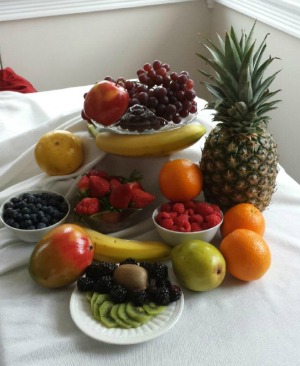Now that you have been teased by that gorgeous waffle from my last blog, drowning in berries and cream, let’s talk about those berries, and fruit in general.
I have to admit that my family, myself included, spent years watching oranges dry up or get blue and fuzzy because we were too lazy to peel them. Strawberries rotted as I didn’t get around to popping out those stems, and mangoes…well, just what is it that I am supposed to do with that overgrown cross between a peach and an avocado? Drinking orange juice was much easier.
But, ahhhh, I have finally seen the light. Did you know that a whole beautiful orange (peeled) contains about 4.3 grams of fiber (about 15% of the required daily amount for women) and about 12 grams of sugar (the good kind), while an 8 ounce glass of orange juice contains the huge amount of ZERO grams of fiber and 22 grams of sugar. Remember that old TV commercial where a dear young lass is wandering through the grocery store with a cart piled high with broccoli, the amount needed to supply her with enough fiber to get her through the day? I’ll eat a few pieces of fruit, thank you.
Make a commitment this week to get in three REAL fruit servings every day. Shoot for two at breakfast. Your body will be so happy.
AND, if you really want to get scientific, according to The World’s Healthiest Foods at www.whfoods.org, “The edible skins of many of the World’s Healthiest Fruits – including apples, apricots, blueberries, figs, grapes, pears, plums, prunes, raisins, raspberries, and strawberries – are all sites of important biological activity in the life of the fruit. The skin is one of the places where the fruit interacts with sunlight, and forms a variety of colored pigments that absorb different wavelengths of light. These pigments, including carotenoids and flavonoids, are well researched as nutrients that protect our health and nourishment. The skins of whole fruits like grapes have actually been studied for their ability to help lower risk of cancer and help provide protection from ultraviolet light.” Wow!

